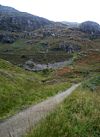Telford's Highland Roads
Between 1805 and c1830, Thomas Telford oversaw the construction of a network of roads to serve the scattered and isolated people of the Scottish Highlands. While the network was never truly completed, it did make travel in the region far easier than ever before. He was also responsible for improving the main Glasgow - Carlisle route, later to become the A74.
Many of the roads he was responsible for were former Military Roads built after the Jacobite Rebellion, but since fallen into disrepair, while others, such as the A830 Fort William - Arisaig road were completely new.
Roads
The United Kingdom at the beginning of the 19th Century had a booming economy. As a result, there was a lot of interest in investment in the transport infrastructure, both Canals and Roads. Turnpike Trusts were set up across England, Wales and southern Scotland to maintain existing routes and build new roads. However, in the remote Scottish Highlands there was no profit to be made by such organisations.
The government commissioned Thomas Telford to survey and propose new routes across the north of Scotland. This included repairs to the Crinan Canal and the consturction of the Caledonian Canal. Other works undertaken in the Highlands included the construction of many new churches and manses. One of the major aims was to reduce the level of emigration and provide work for the local men. Supporters included many of the Highland Landlords, the Fisheries Commission and the Military, whose earlier roads were already in a serious state of disrepair.
Telford's main principles as an engineer on any road, not just in the Highlands, were to minimise gradients, and so use substantial bridges embankments and cuttings. This was to ease the passage of Carriages and other wheeled traffic. The surface was also to be dressed with 'a good depth' of gravel to prevent damage to the hooves of the large herds of livestock that the drovers took south to market.
In order to fund the new roads, a novel set of methods were dreamed up, with only fifty percent of the funds coming from the Government. The local landlords were expected to donate the land required in return for the economic benefits that the road would give them, and it was also their resposibility to assist in the collection, if not actually pay for, the remainder of the money. However the complexities of Scottish law and tenure almost made such a proposition impossible. An Edinburgh Lawyer spent 25 years working alongside Telford's team, to create ways round these problems amongst other aspects of the project. Much of the money therefore came from an early council tax levied by the County Councils for the sole purpose of raising money for the roads.
To start with, the workmen lived on site, either in tents or caravans that were acquired from the war office after the Napoleonic Wars. The caravans could sleep 12-16 men. Compared to the problems that the Army had experienced fifty or so years earlier when trying to build Wade's Military Roads in much the same places, these roads were welcomed by the communities that they served, with many of the local men labouring on site to earn extra money. Later, maintenance gangs still used the caravans when working on the remoter sections of road, but by the end of the 19th Century, this practice had almost died out and finally ceased around the time of the first world war, after which ex-army lorries were used as transport from the local villages.
A full list of known Telford's Highland Roads.
Bridges
In addition to hundreds of miles of roads across Scotland, Telford was also responsible for a huge number of bridges, including Dunkeld Bridge across the Tay, the famous Craigellachie Bridge over the Spey and a large number of the bridges on the A9 north of Inverness, all of which except Bonar Bridge survive to this day, albeit bypassed.
Links
Roads.org.uk
| Telford's Highland Roads | ||
| ||
| ||
| ||
| ||
| ||
|






